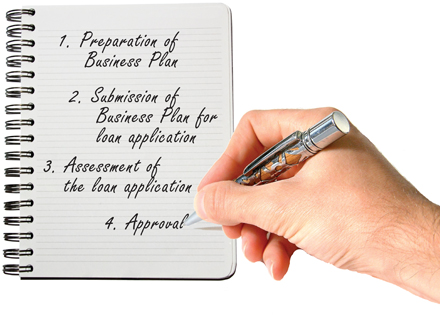Tips on compiling a strong business plan that will impress a bank and why it is so important for franchise businesses to get it right from the start.
Many franchise business people fail to prepare and implement effective business plans which reflect their personal franchising goal. Developing a good business plan will not only help a franchisor and franchisee to avoid pitfalls in their business but can also effectively position it for strong growth.
A good business plan provides a strong, clear and practical road map for the success of a business. It is a tool which can be used as a guide to avoid making mistakes in managing the business and can also be used as reference material when there are prospects for expansion of the business.
A good business plan should contain all the important and relevant information that investors and financial institutions would require to help set up the business. The key elements in a good business plan are:
1) Marketing Plan – i.e. an overview of the business, business model, information about customer base and effective marketing strategies and;
2) Management Plan – i.e. information about the key management team, their qualification and experience and an effective management structure. Integral to these is the financial projection which outlays capex, operating expenditure and a meaningful budget for at least five years.
A bank that wants to start a relationship with an entrepreneur will study his plan thoroughly to know who he is and what exactly he plans to do. A good banker would expect to see a workable plan covering the entire spectrum of the proposed business, i.e. all information about the entrepreneur, his investors or partners, the product or service, viability of the business, sales and marketing mechanism and strategies for growth and of course the financial projections. It is, therefore, important that an entrepreneur preparing a business plan does thorough homework and be realistic in his assumptions.
Generally, there are four broad stages in a loan application process. These are:

Why the need for a Business Plan?
The preparation of a formal and good business plan is not just for new entrepreneurs. It is as important for an on-going established business as it is to a start-up. It should serve six critical functions:
- To help the entrepreneur and/or the management of the business to conduct research on their business and its prospects in a systematic manner before starting the business
- To review the business idea/projects objectively for viability of the business
- To identify weaknesses and challenges in the industry of the proposed business and prepare the necessary plans and strategies to overcome it
- To provide a logical and practical framework within which the business can be set up, developed and pursued, based on strategies to be implemented over a three to five years period
- To serve as a proper reference point and basis for discussion with all parties connected to the business, such as shareholders, prospective investors and financial institutions
- To provide a benchmark against which actual performance of the business can be measured and reviewed
How To Prepare A Business Plan?
A business plan should provide a clear outline of the entrepreneur’s vision of the business. It should show how the business will be managed to achieve its objectives and provide the desired results to the stakeholders. A well-written and structured business plan should provide all the relevant information on the proposed business. It should be straightforward and provide a logical view and understanding of the business.
Just as no two businesses are alike, so is the business plan. Some issues and strategies applicable to some business concepts cannot be applied to other businesses, even in the same industry. It is, therefore, important to tailor a business plan’s contents to suit individual business concepts and models.
A well-prepared business plan will demonstrate that the entrepreneur and/or the management know the business well and that they have thought through its development in terms of current market needs, its growth potential and financial capabilities.
In a business plan, the financial institutions should be able to obtain complete information regarding the business, borrower’s background, the business acumen and financial strength of the borrower, the industry, business projections, strategies and its operational requirements and most important of all the borrower’s capacity to maintain financial obligations.
Key areas of a well-written and structured business plan should include:
- Business model, product/services, vision and goals
- Current position of company, in terms of its financial capacity, current market position and that of its competitors (if available)
- Critical factors for the success of the business
- Current financial requirements/obligations
- Details on how the loan or financial facility will be utilised or could assist the business to meet its current obligations and future needs
A good business plan should incorporate the following basic information:
- Introduction to the business
- Organisation structure of the company
- Business visions and objectives
- Description of products and services offered
- Industry and competitors analysis
- Business strategies
- Sales and marketing strategies
- Financial forecast
- Operational/Financial requirements
It is important to provide full and complete information of the business and ensure that it is accurate at the time of application. This will assist in the speedy and smooth processing of application for loan or financial facility. All the relevant documents as required by the financial institutions should be provided, in accordance to their checklists.

Structure And Content Of A Business Plan
The following factors should be in place before commencing to write a detailed and comprehensive business plan:
- Clear understanding of the customer base and/or the target audience
- Determine the business plan requirements in relation to its contents and level of details
- Plan out the content structure pages
- Decide on the most likely length of the plan
- Clearly identify all the main and critical issues to be addressed
It should be remembered that a good business plan should be seen as a careful and extensive research conducted on the business. Starting to write a business plan before all the key issues have been identified and addressed will not produce the desired results.
A typical business plan comprises the following main elements:
1. Introduction to the Business
Business description:
A brief description of the business; product type, industry overview, target market, current market position the business/company is in, as compared to competitors.
Incorporation details and financial track record:
Date of incorporation, registered address and place of business. For existing business, provide sales and profit record of the company for the last three years.
2. Organisation structure
People are an asset and an important factor in a business. State details of the management team/key personnel or the proposed management team/key personnel for the start-up company, its structure, etc. Indicate the administrative arrangement or duties and specify the salary costs.
3. Business vision and objectives
It is important to highlight the business company’s vision as to how it will evolve and achieve its vision, mission and objectives.
- The vision of the business – its likely physical appearance, in terms of its growth and market position in a time frame of three years and more
- Its Mission – the major objectives i.e. the purpose of the business
- State the business objective in terms of the results expected and wants to be achieved in the medium/long term. It should relate to the expectations and requirements desired by all the major stakeholders, including the employees, and should reflect the strong basis for running the business
4. Description of products and services offered
- Describe the products or services offered State which part of the supply chain the business is in, e.g. as a service provider. Keep description short and confined to broad groups. Explain briefly what makes them special
- Monthly and yearly sales volume and ensure the data given is in line with the industry norm
- Nature of business cycle; regular or cyclical
5. Industry and competitors analysis
- Provide a brief overview of the industry structure and characteristics; the extent of competition and the likely obstacles the business could encounter in entering the industry
- Describe the target markets – in term of size, segments, trends and user/customer profiles
- List out the competitors, i.e. direct competitors and indirect competitors, their market share, strengths/weaknesses to the company’s own position
- Identify the threats, risks and the opportunities present
6. Business strategies
The guidelines and strategies which will assist in achieving the mission and objectives of the business should be stated. It should cover the business as a whole including such matters as diversification, growth or they can relate to primary matters in key functional areas.
The strategies outlined should be based on the company’s strengths and critical success factors in respect to competition in the industry. Effective strategies should focus on the uniqueness or distinctiveness of the product or service. It should be dynamic.
7. Sales and marketing strategies
Provide a brief outline of the company’s marketing strategies for getting customers to buy the products and services offered in respect of its marketing mix, i.e. products, pricing, channels (sales) and promotion.
How will the business market its products/services and sell to customers? What sales will be achieved in its main markets? How it will deal with competitors?
Support market and sales projections by market research. Ensure that there is a direct relationship between the market analysis, sales forecasts and financial projections.
Also provide a brief outline on the company’s programme for after-sales service and support to build customer loyalty, increase repeat buys and the promotion of other products/services.
8. Financial forecast
Three forecasts are required, namely the projected Cash Flow, Profit & Loss and Balance Sheet. The Cash Flow is to be projected on a monthly basis for 24-month duration and on an annual basis for a three years period. Projections of Profit & Loss and Balance Sheet should be computed on an annual basis and prepared for a five years period.
These projections will give bankers an understanding of the cash flow and profits to be generated from the business. It is imperative to prove that the business could generate enough cash to cover the operating expenses and monthly repayments of loan and other financial obligations. It is, therefore, important that the projected cash flow is realistic to assist the bankers to make a proper assessment of the financial facility required.
Use simple tables to present key financial indicators, e.g. summary of profit and loss, cash flow, balance sheet and key ratios. Detailed statements and/or analysis can be provided as appendices. Provide key assumptions used, as follows:
- % cost of capital or main items, raw materials, labour, commissions, etc
- % of cash sales and sales via credit channels
- Credit period given to customers and extended by creditors
Inventory period - % growth per annum
9. Operational/Financial requirements
Summarise funding requirements, possible funding sources, etc. State the type, amount, its purposes, expected duration for the loan to be utilised and expected loan repayment period.
For new businesses, identify the sources of start-up capital for the business, i.e. from shares/paid-up capital, advances from directors, friendly loans and/or advances from family members, friends, associates, etc.
10. Conclusion
State clearly how the business will succeed and why the business plan should be supported. Use this section to wrap up and leave the reader with a good and positive view of the business plan and the proposals made.
11. Appendices
Use appendices at the end of the business plan to present important background details and all the supporting data/information.
The appendices should include statutory documents required by financial institutions, namely:
- Business registration and licence (for partnership and sole proprietorship)
- Memorandum & Articles of Association (M&A)/Partnership Deed
- Certificate of Incorporation (Form 9), Return of Allotment of Shares (Form 24) and Return giving particulars in Register of Directors, etc (From 49) for Corporation/Sendirian Berhad
- Photocopies of IC of directors/partners/proprietor/guarantors
- Form J of directors/guarantors/partners/proprietor
- Income tax returns of the business (for sole proprietorship and partnership). Only applicable for on-going businesses
- Audited accounts for the past three years (if latest audited accounts are not available; provide Draft or Management Accounts)
- Past six months’ current account statements of the business, from financial institutions (if any)
- Disclosure of all borrowings with other financial institutions together with copies of letters of offer and loan agreements (if any)
- Detailed cash flow projection
- Aging list of business creditors and debtors
- Security documents as collateral (if any)

Submission Of Loan Application
Time is crucial in business. Therefore, an entrepreneur should be able to forecast his financial needs and submit his business plan for financial facility as early as possible, giving the bankers sufficient time to make the proper assessment, process and approve the facility. It must also be noted that more time will be taken by bankers, should they require additional information and more supporting documents.
The financial institution may want to conduct interviews with the entrepreneur and/or the key management people at the time of submission and may also conduct a site visit to the business premises to better understand, verify and assess the financial needs.
Questions raised by the financial institutions would relate to the nature of business, management structure and market positioning, i.e. market share, competitors, market outlook, i.e. demand for the products/services offered, future plans and product life cycle.
After submission, follow-up with the relevant officer or personnel of the financial institution and keep track of the status of the application.
Conclusion
An entrepreneur as the would-be borrower must be prepared with the correct knowledge and understanding of the business before approaching a banker for financial facilities. Bankers have high regard for business people who set their goals based on good business principles and realistic projections.

Zainudin Hj Zakaria is a banker by profession having more than 30 years of experience in the banking industry. He is currently one of the Executive Committee (EXCO) members of the Malaysian Franchise Association.







I would like to know if you offer the service of writing the business plan.
As above give a nice post. It’s give a batter idea to started your own business. That’s give a good description for the different types of business plan.
where can I get the template or sample of it ? thank you